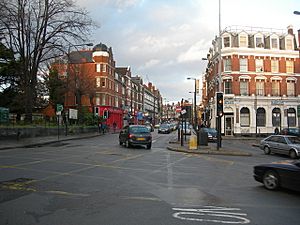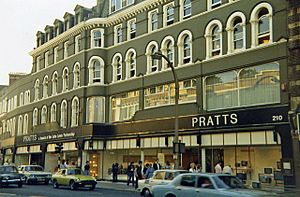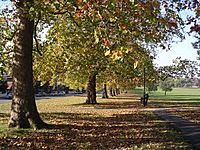Streatham facts for kids
Quick facts for kids Streatham |
|
|---|---|
 Streatham High Road, looking north from the junction with Mitcham Lane |
|
| Population | 58,055 (2011) |
| OS grid reference | TQ305715 |
| London borough | |
| Ceremonial county | Greater London |
| Region | |
| Country | England |
| Sovereign state | United Kingdom |
| Post town | LONDON |
| Postcode district | SW2, SW16 |
| Dialling code | 020 |
| Police | Metropolitan |
| Fire | London |
| Ambulance | London |
| EU Parliament | London |
| UK Parliament |
|
| London Assembly |
|
Streatham (/ˈstrɛt.əm/ STRET-əm) is a lively area in south London, England. It is about 5 miles (8 km) south of Charing Cross, a famous spot in central London. Most of Streatham is in the London Borough of Lambeth, but some parts are in the nearby London Borough of Wandsworth.
Streatham used to be part of Surrey county. Then, in 1889, it became part of the County of London. Later, in 1965, it joined Greater London. Today, Streatham is known as one of the 35 main centres in Greater London.
Contents
Exploring Streatham's Past
The name Streatham means "the village on the street." This street was an old Roman road that went from London to the south coast. It was an important route for travel and trade long ago.
Streatham's first church, St Leonard's, was built in Saxon times. Only an old tower from the Tudor period remains from the original church. The rest of the church was rebuilt in 1831. In medieval times, the area covered by the church was much larger. It included places like Balham and Tooting Bec.
Records show that in the late 600s, land in Streatham was given to Chertsey Abbey. This was a special gift from important people like Erkenwald and Frithwald.
Streatham is even mentioned in the Domesday Book of 1086. This was a big survey of England ordered by William the Conqueror. Back then, Streatham was called Estreham. It was owned by Bec Abbey from Normandy. The survey noted its land and how much money it made each year.
After the Romans left, the main road through Streatham stayed important. From the 1600s, it became a major route for coaches going to Croydon and East Grinstead. Later, in 1780, it became part of the main road from London to Brighton. This road, now known as the A23, has really shaped how Streatham grew over time.
Streatham's Healing Springs
Streatham was mostly a small village until the 1700s. That's when its natural springs, called Streatham Wells, became famous. People believed the water had special health benefits. The idea of a "spa" and better roads brought rich people from London to build country homes in Streatham.
Even as London grew, Streatham village didn't change much until the late 1800s. Later, Streatham Vale grew to the south. A small group of shops near Streatham Common Station is now known as Streatham Village.
Wellfield Road was renamed to show it was the main path to one of the well locations. Another mineral well can still be seen today on the south side of Streatham Common, in an area called The Rookery.
Streatham Park: A Place for Famous Guests
In the 1730s, a grand house called Streatham Park was built. It was a large country mansion owned by a brewer named Ralph Thrale. Later, his son Henry Thrale and his wife Hester Thrale lived there. They loved to host famous writers and artists of their time.
One of their most famous guests was Samuel Johnson, who created the first English dictionary. The dining room at Streatham Park had 12 portraits of Henry's guests. These were painted by his friend Joshua Reynolds. A writer named Fanny Burney cleverly called these paintings the "Streatham Worthies."
Streatham Park was later rented by Lord Shelburne, who became Prime Minister. Important talks happened here that led to the Peace Treaty of 1783. Sadly, Streatham Park was taken down in 1863.
Park Hill and Henry Tate
One large house that is still standing today is Park Hill. It's on the north side of Streatham Common. It was rebuilt in the early 1800s for the Leaf family. Later, it became the home of Sir Henry Tate. He was a sugar refiner and gave a lot of money to build local libraries, including Streatham Library. He also started the famous Tate Gallery in London.
How Streatham Grew into a Town
Streatham started to grow much faster after the Streatham Hill railway station opened in 1856. Two more railway stations opened within 15 years.
Some areas, like Telford Park, were planned with lots of space and even had tennis clubs. Other streets were built in more typical suburban styles. Three new churches were built to serve the growing number of people living in Streatham. Today, you can see buildings from the last 200 years, showing how Streatham has changed.
Streatham in the Early 1900s
After the First World War, Streatham became a popular place for entertainment. It had the Streatham Hill Theatre, three cinemas, a big ballroom called the Locarno, and the Streatham Ice Rink. This gave Streatham the nickname "the West End of South London."
With electric tram services, Streatham also became a busy shopping area. In the 1930s, many apartment buildings were built along the High Road. These buildings didn't fill up right away. But they became home to many people who came to London after leaving countries controlled by Hitler's Germany.
Shopping and Modern Streatham
In the 1950s, Streatham had the longest and busiest shopping street in south London. It was even home to the UK's first supermarket in 1951!
However, over time, shopping in Streatham faced challenges. People moved to other towns, and the main road (A23) became very busy with traffic. In 1990, a large department store called Pratts closed down. A big new supermarket also opened further south, drawing shoppers away.
Recently, things have been improving. New shops like Argos and Lidl have opened. More restaurants, bars, and coffee shops have also appeared.
In 2011, Streatham received special funding from the Mayor of London to make improvements. This money helped to clean up shop fronts, replace signs, and make public spaces nicer. Streatham Library also got a big makeover. The old Tudor Hall behind the library was reopened as The Mark Bennett Centre, a place for meetings and performances. New lighting was added to highlight beautiful buildings, making the area safer and more attractive.
Streatham Today
In 2002, Streatham High Road was voted the "Worst Street in Britain" in a poll. This was mainly because of all the traffic. But plans to improve the area were already underway. Work began to fix up Streatham Green and repave the High Road. In 2005, Streatham Green won an award for being the best public open space in London!
The poll helped local councils and transport groups work together to make more improvements. This included fixing up other parts of the High Road.
The Streatham Festival started in 2002. It has grown into a big event with over 50 activities. These events happen in many different places, from cafes to churches and parks, attracting thousands of people.
A big project called the Streatham Hub started in 2011 near Streatham railway station. This project replaced the old Streatham Ice Arena and Leisure Centre with a brand new leisure centre and a large supermarket with apartments above it.
In November 2013, the new Streatham Ice and Leisure Centre opened. It has a large indoor ice rink with seats for 1,000 people. It also has a swimming pool, a teaching pool, a sports hall, and a gym.
Streatham also has a jazz club called Hideaway. It keeps Streatham's long tradition of entertainment alive. It hosts live jazz, funk, and soul music, as well as comedy nights. It even won an award for being the Jazz Venue of the Year in 2011!
How Streatham is Governed
Streatham is managed by the Lambeth London Borough Council. It is also part of the parliamentary constituency with the same name.
Who Lives in Streatham?
According to the 2011 census, Streatham is a very diverse place. The population is made up of people from many different backgrounds. The largest group is White British, but there are also many Black, Asian, and mixed-heritage people living in the area.
Schools in Streatham
Streatham has many schools for children and young people:
- Bishop Thomas Grant School
- Dunraven School
- Woodmansterne School
- Streatham & Clapham High School
- London Steiner School
- Sunnyhill Primary School
- Hitherfield Primary School
- Streatham Wells Primary School
- St Andrews RC Primary School
- Goldfinch Primary School
- Penwortham Primary School (Wandsworth)
- St Leonard's Primary School
- Broomwood Hall Lower School
- Henry Cavendish Primary School (Streatham campus)
Sports Teams
Streatham is home to a few sports teams:
- Streatham RedHawks (ice hockey)
- Streatham-Croydon RFC (rugby)
- Streatham Rovers FC (football)
Places of Worship
Streatham has many different places where people can worship:
- St Leonard's Church (Church of England) - the oldest church
- English Martyrs' Church (Roman Catholic)
- Christ Church, Streatham Hill (Church of England)
- Holy Redeemer Church, Streatham Vale (Church of England)
- Immanuel and St Andrew Church, Streatham (Church of England)
- St Margaret the Queen, Cricklade Avenue, Streatham Hill (Church of England)
- St Peter's Church, Streatham (Church of England)
- St Simon and St Jude, Hillside Road, Streatham Hill (Roman Catholic)
- Streatham Baptist Church, Lewin Road
- Hambro Road Baptist Church
- Streatham Methodist Church, Riggindale Road
- New Covenant Church, Pendennis Road
- Islamic Centre, Estreham Road (Shi’a)
- Streatham Friends Meeting House, Roupell Park Estate (Religious Society of Friends (Quakers))
- Streatham Mosque, Mitcham Lane (Sunni)
- Streatham Hill Mosque, Norfolk House Road (Sunni)
- South London Synagogue, Leigham Court Road (United Synagogue)
- South London Liberal Synagogue, Prentis Road (Liberal Judaism)
- Hitherfield Road Baptist Church Streatham
- St James' Streatham, Mitcham Lane
- Mitcham Lane Baptist Church, Mitcham Lane
- St Albans - Evangelical, Pretoria Road
- Streatham Central Church, Wellfield Road
Famous People from Streatham
Many well-known people have lived or worked in Streatham, or have a connection to the area. Here are just a few:
- Arthur Anderson, who helped start the P&O shipping company
- Lynda Baron, actor
- Floella Benjamin, actress and TV presenter
- Naomi Campbell, famous model
- Simon Callow, actor
- Dave, rapper
- Peter Davison, actor
- Eddie Izzard, comedian and actor
- Dr Samuel Johnson, famous writer and dictionary maker
- Sadiq Khan, the Mayor of London
- John Major, who was Prime Minister from 1990 to 1997
- Roger Moore, actor, known for playing James Bond
- Paul Merton, comedian
- Sir Joshua Reynolds, famous artist
- Henry Tate, who gave money for libraries and started the Tate Gallery
- Hester Thrale, writer and supporter of the arts
- Tommy Trinder, comedian
- June Whitfield, actress
- Bill Wyman, musician from The Rolling Stones
Nearby Places
Here are some other places close to Streatham:
- Balham
- Brixton
- Colliers Wood
- Clapham Park
- Crystal Palace
- Furzedown
- Herne Hill
- Mitcham
- Norbury
- Pollards Hill
- Thornton Heath
- Tooting
- Upper Norwood
- West Norwood
- Wimbledon
Getting Around Streatham
Train Stations
Streatham has three train stations: Streatham, Streatham Common, and Streatham Hill. You can also find stations nearby at Balham and Norbury.
Tube Stations
The closest tube stations are at Brixton, on the Victoria line, and Tooting Bec, on the Northern line.
See also
In Spanish: Streatham para niños






